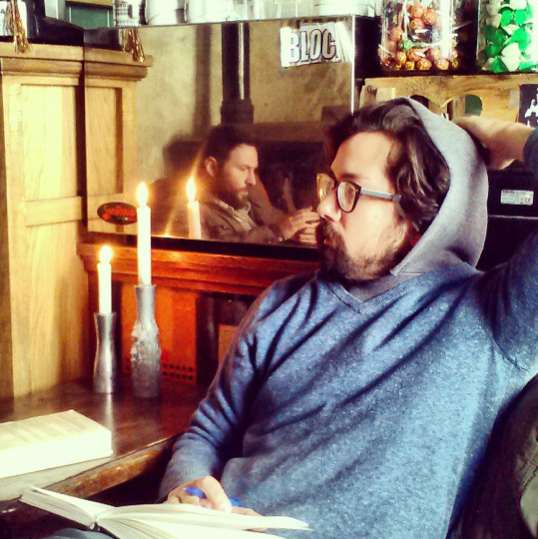by Brandon Shimoda
Softcover / 96 p. / Poetry
ISBN: 978-0-9844752-3-0
Brandon Shimoda is the author of a few books, including The Girl Without Arms, published by Black Ocean in 2011, and Portuguese (Octopus Books & Tin House, 2013). He has collaborated with artists and writers, including Sommer Browning, Julia Cohen, Lucas Farrell, James Jack, Karen McAlister Shimoda, and Phil Cordelli, with whom he is The Pines. Born in California, he has lived most recently in Arizona, Nova Scotia, and Taiwan.
Praise
The precondition for a reckless power, a knowingly foolhardy, sometimes comic investigation of what our instincts know.
—Publishers Weekly
Brandon Shimoda seems to be an Ur-being, a totally new creature: And I never wanted children, but now / I want children / To drop / Through skeletal netting / Nameless / Into black beds / As like into potters aglow in generous helpings of children. His language changes natural laws. We, standing by, reading, shivering in awe, are stopped. Mute, then refreshed and launched. His children.
—Tomaž Šalamun
Brandon Shimoda’s The Girl Without Arms is a whirlwind of language. I got lost in the turning and I was so happy to be lost, for once. Because the genius of poetry is to make you feel like you always want to be lost in a cone of words and light, twisting around what may have started out as your one self but is now so many selves. And twisting, tearing, and splitting you so pleasantly into many selves is exactly what this book does.
—Dorothea Lasky
Sometimes I can taste the world in a poem. Sometimes there is a poet in service to deliver everything you want to taste in the world. Brandon Shimoda is such a poet. If every book he writes is as good as The Girl Without Armsthere will be many years of never going hungry. Some people have faith in god, but I have faith in Poetry. I have faith in Brandon Shimoda.
—CAConrad
Of himself and his work Brandon writes:
I was born in the San Fernando Valley of southern California, to an Irish-Scottish girl and a Japanese boy. They were married in the Swiss Alps in the early 70’s. They were children at the time, and have sustained themselves as fortunately so, for now I count them both among my siblings. My mother is a visual artist and my father founded a non-profit organization based out of Laos. My sister, Kelly, is a photographer; her photos compose a resource of astonishingly acute feeling—especially feeling possessed by people in and out of their element—that I am in continual awe of, and constantly fail to enact in my own work. The three of them—my mother, father and sister—are a basic part of my motivation, the four of us obscured by the problems that refuse to sway, giving rise to a fruitful and communal elaboration of energies. Another principal motivation is my father’s father, Midori Shimoda—also a photographer, imprisoned in a federal detention center in Montana during the second World War for being one. And for being Japanese; he was born in Hiroshima, in 1910, emigrated to the U.S. in 1919, though was not granted citizenship until 1955.
My first memories are of living in Belgium, in the early 80’s, where I began to develop my interests and animosities. There were epic and stately trees in that country, though I spent a great deal of time in the basement of our house—arranging things, lining things up, making shapes on the floor. On the weekends we traveled around Europe. I recall a cavalcade of paintings and statues, narrow canals, wet stones and bright hillsides. Though I’ve returned many times since, this genesis became the crucial movement, and the chorus of bells in the Alps ...
Everything thereafter has been a moving in and out of cities and the wilderness. I love the wilderness of people, and the wilderness of art. I am constantly failing both, though finding some solace and salvation in that failing. There is a kind of negative space that overwhelms me when I’m walking around, eating sandwiches, sitting in a chair, looking at the arms of my friends—poetry is one means of giving a form to that negative space; making things is another. I have always been fascinated with creators—artists, and painters especially—the way they work, the conditions they take for that work, and the ways in which they talk about it. I studied and made art from a young age, and only started to write poems when the conditions prevented anything larger, more material, from taking place. (This was in Brooklyn, in 2000). Some day I hope it becomes something else … aspirations of going to the festival, for example, with both arms mightily intact.
There are many people to whom I turn to be renewed in my own thinking and work, included among whom are poets and artists, musicians and filmmakers, and especially good friends and family members. I regularly read works in translation, most recently from the Arabic (Sabah Zwein, Unsi al-Hajj, Muhammed al-Maghut) and Japanese (Ryuichi Tamura, Kazuko Shiraishi, Gozo Yoshimasu, Minoru Yoshika). I read a lot of writer’s and artist’s journals and letters. I am building a library of volumes on the bombing of Hiroshima. Field guides never cease in their benefits. I find great confirmation in the work of many of my good friends and peers—some of them toiling the fish ladder of academia, some of them making their days as farmers—all of them poets and writers in the truest sense, and I make a rule of paying close attention to all of their work. I am constantly envisioning a time when we might all congregate in a field somewhere, for a meal without conceivable end. The time will never come, I know, but so goes the inflation of vision, and my heart ...


